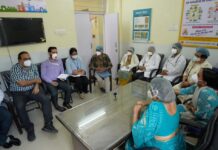
NEW YORK: They look intently at the camera, some impassively, some with smiles, all of them aware that they’ve just shared with an online audience a most personal story: Why they tried to kill themselves.
By the dozens, survivors of attempted suicide across the United States are volunteering to be part of a project by a New York-based photographer, Dese’Rae Stage, called “Live Through This” – a collection of photographic portraits and personal accounts.
It’s one of several new initiatives transforming the nation’s suicide prevention community as more survivors find the courage to speak out and more experts make efforts to learn from them. There’s a new survivors task force, an array of blogs, some riveting YouTube clips, all with the goal of stripping away anonymity, stigma and shame.
“Everyone feels like they have to walk on egg shells,” says Stage, who once tried to kill herself. “We’re not that fragile. We have to figure out how to talk about it, rather than avoiding it.”
Such conversations are proliferating.
In January, the American Association of Suicidology launched a website called “What Happens Now?” – described as the first sustained effort by a national organization to engage survivors in a public forum. It features a blog, updated weekly, with contributions from survivors sharing their experiences and often using their real names.
In one of the latest posts, the founder of a respite home for suicidal people writes powerfully about her own suicide attempt eight years ago, involving both pills and a kitchen knife, and about the contributions that survivors can bring to prevention efforts.
“Survivors have a unique perspective on what life’s like down in the deep, dark hole,” writes Sabrina Strong, executive director of Waking Up Alive in New Mexico. “We found our way out… We’re not afraid to crawl down in the dark hole with someone else.”
Seeking to encourage those types of contributions, the National Action Alliance for Suicide Prevention – a federally funded public-private partnership – has formed a first-of-its-kind task force comprising prevention experts and survivors. It plans to issue recommendations this year for how practitioners and organizations in the prevention field can “engage and empower suicide attempt survivors.”
One of the task force co-chairs is psychologist John Draper, project director of the National Suicide Prevention Lifeline, a network of centers that field calls from emotionally distressed and potentially suicidal people.
According to studies cited by Draper, about 7 percent of survivors later kill themselves, a far higher rate than for other groups. “Yet that means 93 percent go on to live out their lives,” he said. “We’ve got to talk to them, engage them, find out what is bringing them hope and keeping them alive.”
In past decades, the stigma surrounding suicide was intense, and most people who tried to kill themselves avoided any public disclosures about their experiences. There was far more involvement in the prevention movement by bereaved relatives of people who completed a suicide.
Among them was Michelle Linn-Gust, whose sister killed herself at 17 and who, in her current role as president of the American Association of Suicidology, helped launch the “What Happens Now?” website.
“The bereaved, the people who’ve lost someone, like me, that movement has taken off,” Linn-Gust said. “But the attempt survivors have not had a voice. Nobody has given them a home.”
Over the years, individuals who had attempted suicide would surface occasionally, writing books or going on the public-speaking circuit to share their experiences. One such communicator is Kevin Hines, who became a prolific writer and speaker after surviving a jump from the Golden Gate Bridge in 2000.
A survivor in Canada, David Granirer, has carved out a specialty as a stand-up comedian whose monologues address depression and mental illness. Among Granirer’s routines is a feigned phone conversation in which he unsettles a smarmy telemarketer. “I’m so depressed,” he says. “If you hang up, I’ll kill myself.”
What’s new in the past couple of years is a broader phenomenon – a surge of collective projects by survivors, corresponding with a keener and more systematic interest by prevention experts in their potential contributions.
“The voices of people who have thought about suicide and possibly attempted suicide have been largely absent from public conversations about suicide and what should be done about it,” says Karen Butler Easter, president of National Association of Crisis Center Directors. “They know what hurts, and they know what helps.”
One asset that survivors say they can supply is candor.
“We are willing to speak truthfully, even if others are afraid to,” writes Sabrina Strong in her recent blog post. “We understand that we do others a disservice by providing generic and whitewashed advice from the school of magical thinking – `Things will get better.’ `Everything’s all right.’
“Sometimes things don’t get better, at least not right away.”
Historically, prevention specialists made relatively little effort to seek input from people who tried to kill themselves. Experts say treatment often was – and in some cases still is – condescending, and at times harsh and punitive.
“The attitude was that if a person tried to kill themselves, they were irresponsible, they were not people we could trust, and we knew what’s better for them,” said John Draper. “There also was some concern that they might kill themselves if we engaged them.”
Those attitudes have evolved in recent years, with more interest in collaborative treatment. Yet prevention experts say many therapists lack specialized training in how to deal with survivors and balk at treating them because their above-average rate of eventually killing themselves prompts fear of malpractice suits by their families.
Among those serving with Draper and Vega on the new task force is Heidi Bryan, who survived a suicide attempt in the 1980s and whose brother did kill himself.
Bryan, 55, has been active for more than a decade in suicide prevention initiatives and has observed notable changes in how experts view survivors.
“I remember sitting at a conference when speakers were talking about survivors – it was like we were lab rats,” she said. “Now they’re finally realizing maybe we should be brought in on this. We need to erase the misperceptions that people have about us, so we’re treated with the respect we deserve.”
To help survivors think through the consequences of sharing their story, major prevention organizations recently teamed up to offer guidelines and suggestions. -AP






